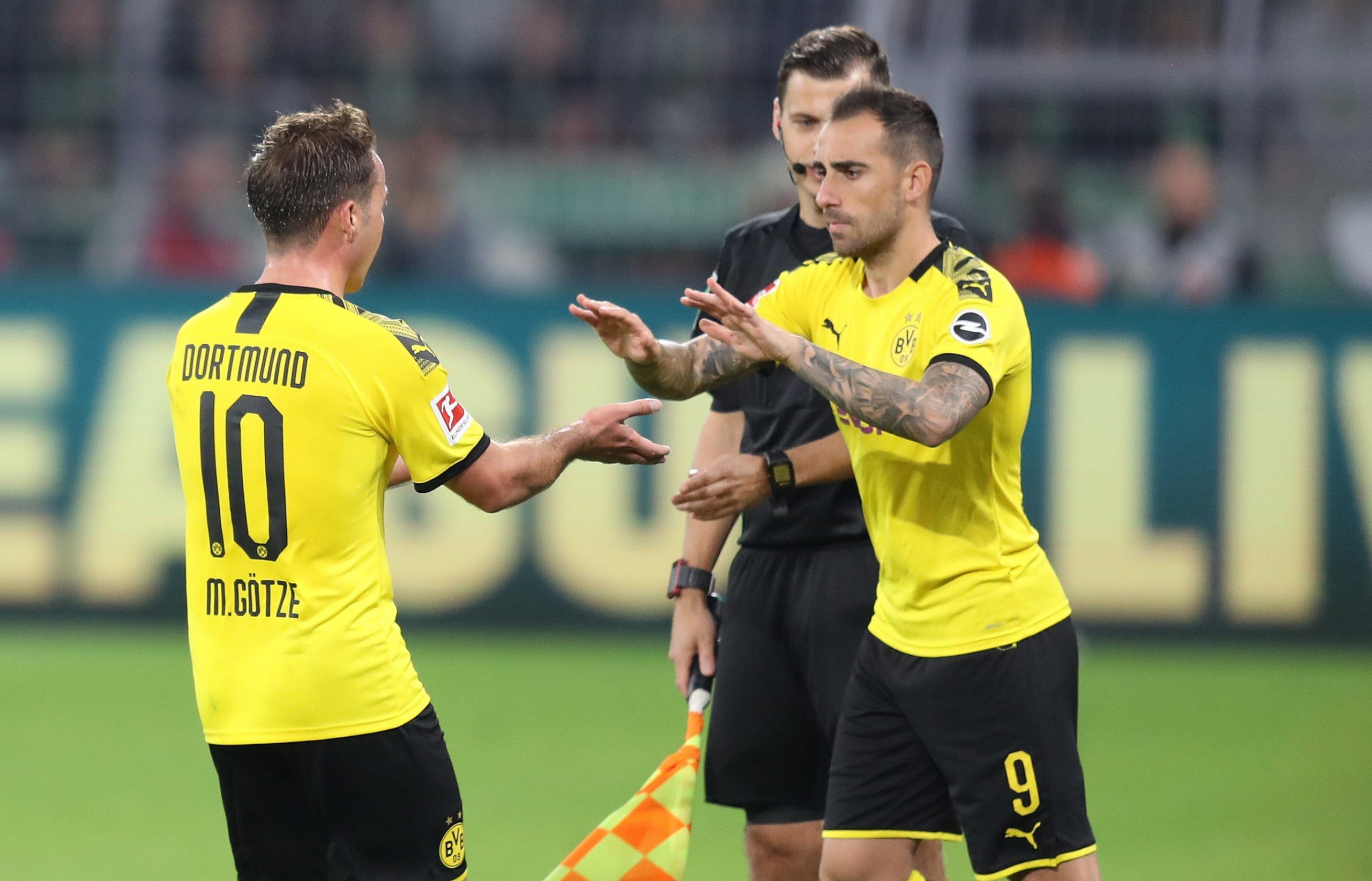Borussia Dortmund are, in a sporting sense, in trouble. The league table fails to fully reflect the situation, but a number of performances over the last few weeks were, particularly in attack, alarmingly harmless. Before the season, questions were asked centred on the personnel situation in the striker department and whether BVB should buy another alternative to Paco Alcácer. Those questions are now more pressing than ever. Alcácer performed very well on the first five matchdays of the Bundesliga, which he spent as part of Dortmund’s starting XI. His attacking presence, contribution to shooting attempts and efficient playing style in the opponent's penalty box make him a valuable asset. His absence after the match against Werder Bremen became noticeable immediately. 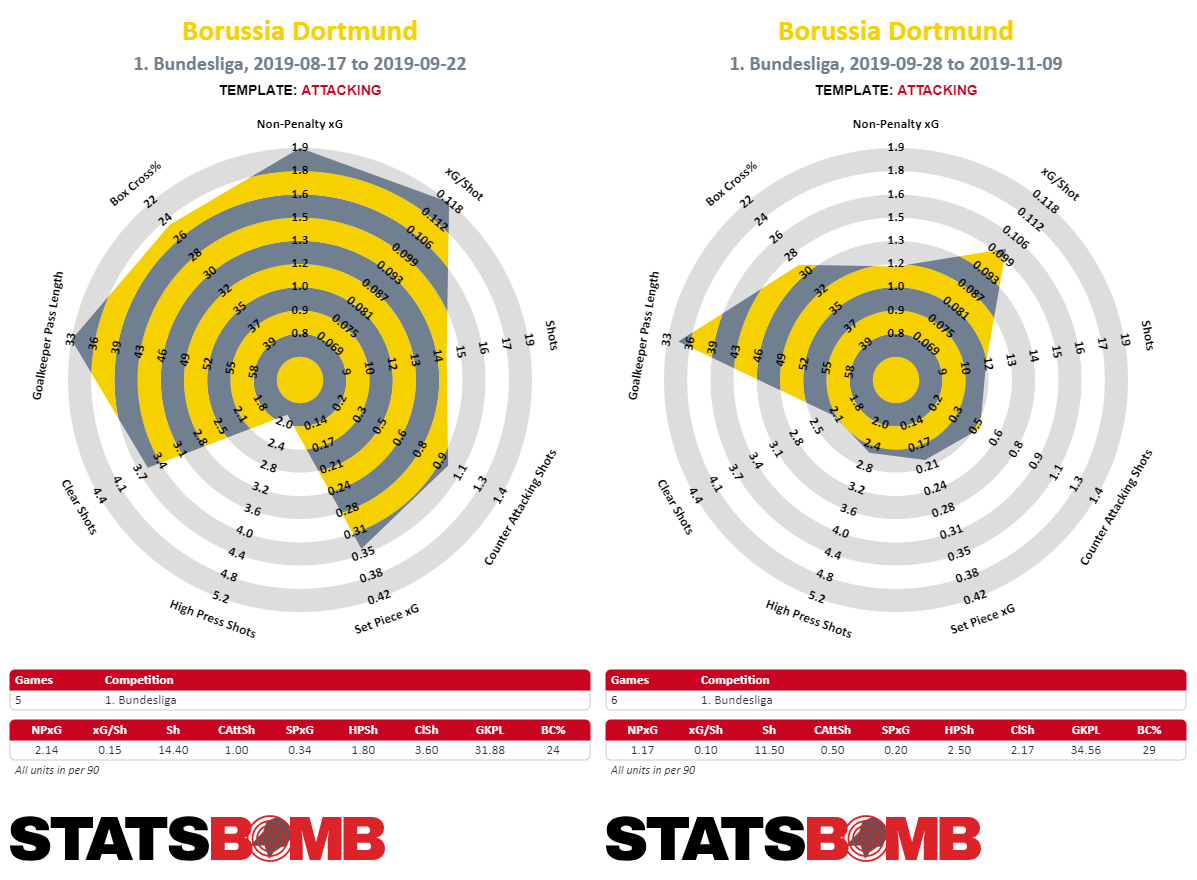 Comparison of Dortmund’s values in attack until Alcácer’s absence and since. Overall, Dortmund amassed fewer shots, while at the same time being less creative in attack, which one can infer from the larger rate of crosses, for example. Obviously, the toothless attacking performances were not singularly down to the absence of Alcácer, seeing as Dortmund faced some of the powerhouses of the league in Schalke, Mönchengladbach and Bayern, who all know to be solid defensively in their own ways. Still, it became evident that Dortmund do not have an adequate replacement at hand to allow the ball progression to flow through that one important target player, particularly in the transition into the final third and even more so when playing into the box. Mario Götze adds a number of qualities, but he is often used incorrectly when played at the very front of the formation. He would be of better use in central midfield, where his footballing intelligence and compartmentalised playing style would shine through for the better of the team. For the moment, though, Götze seems to have been tabbed as Alcácer’s replacement. However, this cannot be a long-term solution for a club as ambitious as BVB, especially as Götze’s time with the club may be over in the summer.
Comparison of Dortmund’s values in attack until Alcácer’s absence and since. Overall, Dortmund amassed fewer shots, while at the same time being less creative in attack, which one can infer from the larger rate of crosses, for example. Obviously, the toothless attacking performances were not singularly down to the absence of Alcácer, seeing as Dortmund faced some of the powerhouses of the league in Schalke, Mönchengladbach and Bayern, who all know to be solid defensively in their own ways. Still, it became evident that Dortmund do not have an adequate replacement at hand to allow the ball progression to flow through that one important target player, particularly in the transition into the final third and even more so when playing into the box. Mario Götze adds a number of qualities, but he is often used incorrectly when played at the very front of the formation. He would be of better use in central midfield, where his footballing intelligence and compartmentalised playing style would shine through for the better of the team. For the moment, though, Götze seems to have been tabbed as Alcácer’s replacement. However, this cannot be a long-term solution for a club as ambitious as BVB, especially as Götze’s time with the club may be over in the summer. 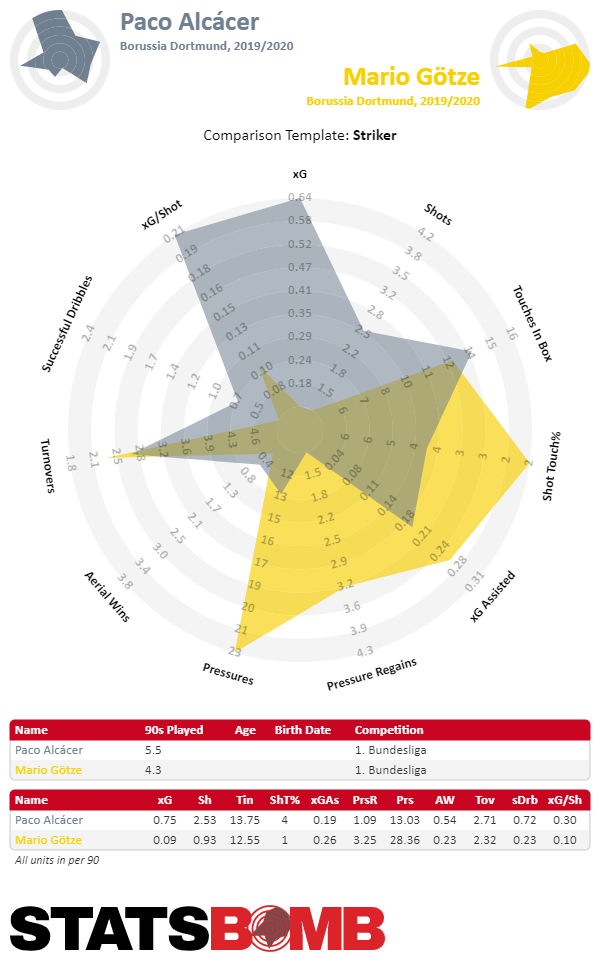 Götze and Alcácer could hardly be any more different from one another—even if we dismiss the context of the games. This holds especially true for the way they integrate themselves into general play, but also for their options in counter-attacks and fast attacks.
Götze and Alcácer could hardly be any more different from one another—even if we dismiss the context of the games. This holds especially true for the way they integrate themselves into general play, but also for their options in counter-attacks and fast attacks.
What, exactly, is Alcácer?
A striking thing about Alcácer is how he can adapt his playing style to respective situations in a match. When Dortmund are dominating a game, with long spells of possession, he positions himself mostly in the centre of the field of play to intuitively remain a passing option for the attacking players next to and behind him. He is present in proximity to the opponent’s defenders and occupies them, so that they cannot move up and defend more proactively or intercept inverse movements from a player such as Jadon Sancho. When Dortmund have to counter from deeper positions, though, as was the case in the first half against Bayer Leverkusen, as Bayer played a quite intensive midfield pressing, Alcácer frequently drifts to one side. In this particular game, he moved toward the left, attempted to intercept medium-high passes that came through the channels of Lars Bender and Kai Havertz and to enter sprinting contests with Jonathan Tah. 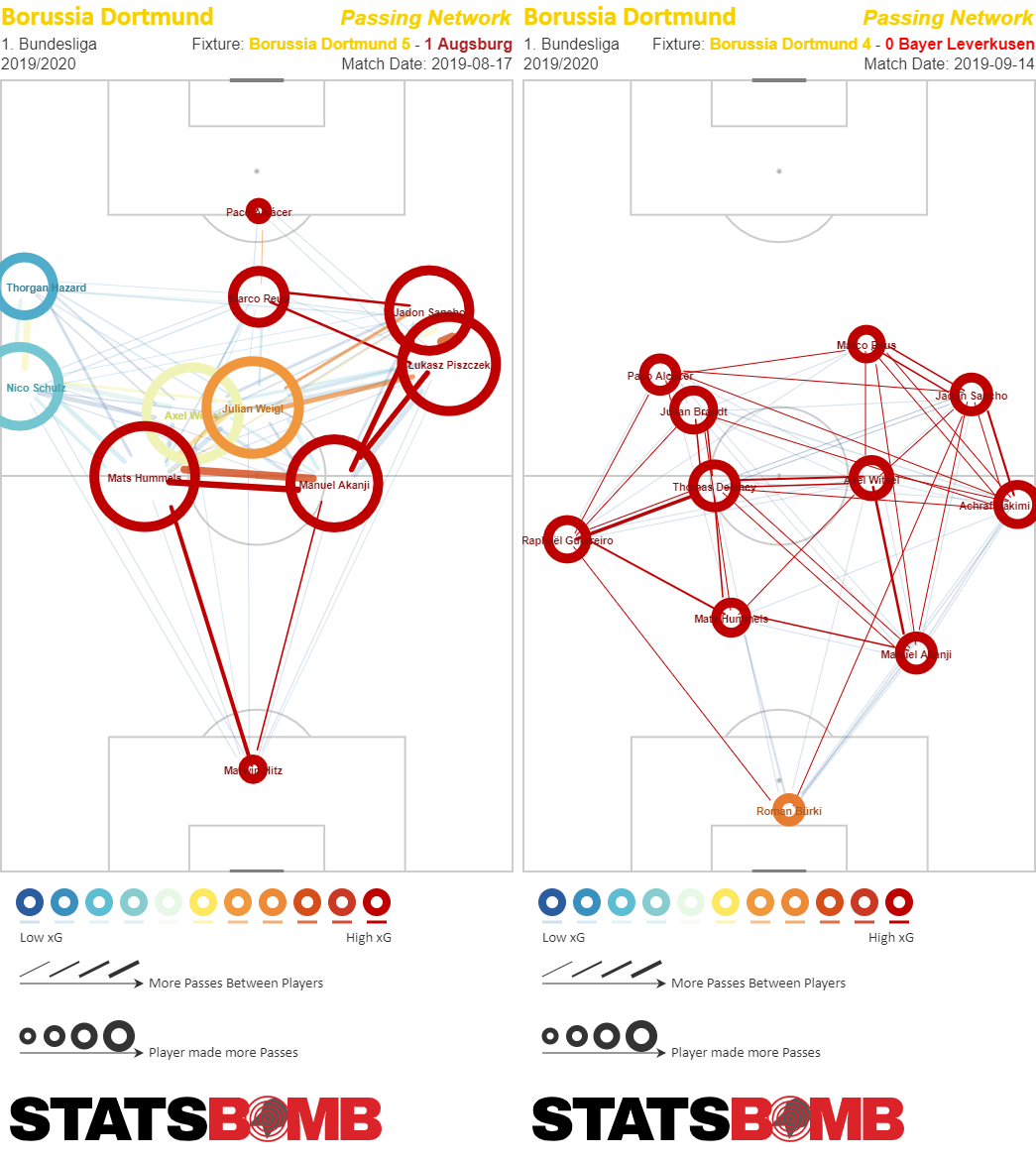 In the inaugural league match of the season, BVB played quite asymmetrically, with Alcácer as a central target player. Against Leverkusen, on the other hand, Alcácer moved toward the left side frequently, especially in a tough first half. He received passes and tried to carry on Dortmund’s counter-attacking. This is Alcácer’s big strength: He is neither a classic penalty-box striker (despite his eye for goal and intelligent positioning), nor is he a true counter-attacker (despite his quickness and evasive movement). He unites both elements very well, making him the perfect striker for BVB, seeing as they have to adapt their playing style on occasion because of their vulnerability against a high press. An Alcácer copy? This short analysis then poses the question of whether Dortmund should make an effort in the coming summer to sign a “second” Paco Alcácer. The statistical numbers from this and last season show that the Bundesliga have a few strikers that would fit that bill and have a statistical resemblance of roughly 80%. First, Kevin Volland, who has transformed into a central target player recently but can still play through the half-space given his career history. Peter Bosz has used him on the left wing five times this season, from where Volland moved inwards frequently and always attempted to create proximity to the central striker. Volland can perform similarly evasive movements in a counter-attacking scheme to those of Alcácer and carry on the attack. Another tactically flexible striker who falls in the statistical category of Alcácer is Andrej Kramarić. In the current campaign, a knee injury has limited the Croatian to only two appearances. But in recent years at Hoffenheim, he has regularly proved he can play his part in the attack both from the centre and from a position in the left half-space. He distinguishes himself from Volland insofar as he generates more high-quality shooting attempts, while at the same time playing with more risk, especially when deployed up front, losing the ball more frequently than Volland. The third striker in this equation is Alfreð Finnbogason, but he cannot be an option for Dortmund based on his age, career to this point and susceptibility to injury.
In the inaugural league match of the season, BVB played quite asymmetrically, with Alcácer as a central target player. Against Leverkusen, on the other hand, Alcácer moved toward the left side frequently, especially in a tough first half. He received passes and tried to carry on Dortmund’s counter-attacking. This is Alcácer’s big strength: He is neither a classic penalty-box striker (despite his eye for goal and intelligent positioning), nor is he a true counter-attacker (despite his quickness and evasive movement). He unites both elements very well, making him the perfect striker for BVB, seeing as they have to adapt their playing style on occasion because of their vulnerability against a high press. An Alcácer copy? This short analysis then poses the question of whether Dortmund should make an effort in the coming summer to sign a “second” Paco Alcácer. The statistical numbers from this and last season show that the Bundesliga have a few strikers that would fit that bill and have a statistical resemblance of roughly 80%. First, Kevin Volland, who has transformed into a central target player recently but can still play through the half-space given his career history. Peter Bosz has used him on the left wing five times this season, from where Volland moved inwards frequently and always attempted to create proximity to the central striker. Volland can perform similarly evasive movements in a counter-attacking scheme to those of Alcácer and carry on the attack. Another tactically flexible striker who falls in the statistical category of Alcácer is Andrej Kramarić. In the current campaign, a knee injury has limited the Croatian to only two appearances. But in recent years at Hoffenheim, he has regularly proved he can play his part in the attack both from the centre and from a position in the left half-space. He distinguishes himself from Volland insofar as he generates more high-quality shooting attempts, while at the same time playing with more risk, especially when deployed up front, losing the ball more frequently than Volland. The third striker in this equation is Alfreð Finnbogason, but he cannot be an option for Dortmund based on his age, career to this point and susceptibility to injury.
A Physical Alternative
The search for an alternative to Alcácer can also be looked at from a different perspective. The cry for a physically strong striker grows louder by the day. And Lucien Favre, despite what he may have said publicly, has given chances to large target players over his career. Such a signing cannot be ruled out at the moment, anyway. Even more so since, in certain matches, BVB manage quite well to perfectly prepare breakthroughs to the touchline through a player like Achraf Hakimi. Sancho is essentially more of a half-space striker than wing-attacker. As such, one side of Dortmund's team could create assists without sending in useless crosses. Additionally, a striker competent in aerial duels could be a receiving option for Mats Hummels’ early long balls against an attacking press. To find such a striker, the search criteria for Bundesliga players must be defined accordingly: The striker still has to be reliable on the ball, able to be a part of the general attacking play and at the same time bring a significant prowess in the air. 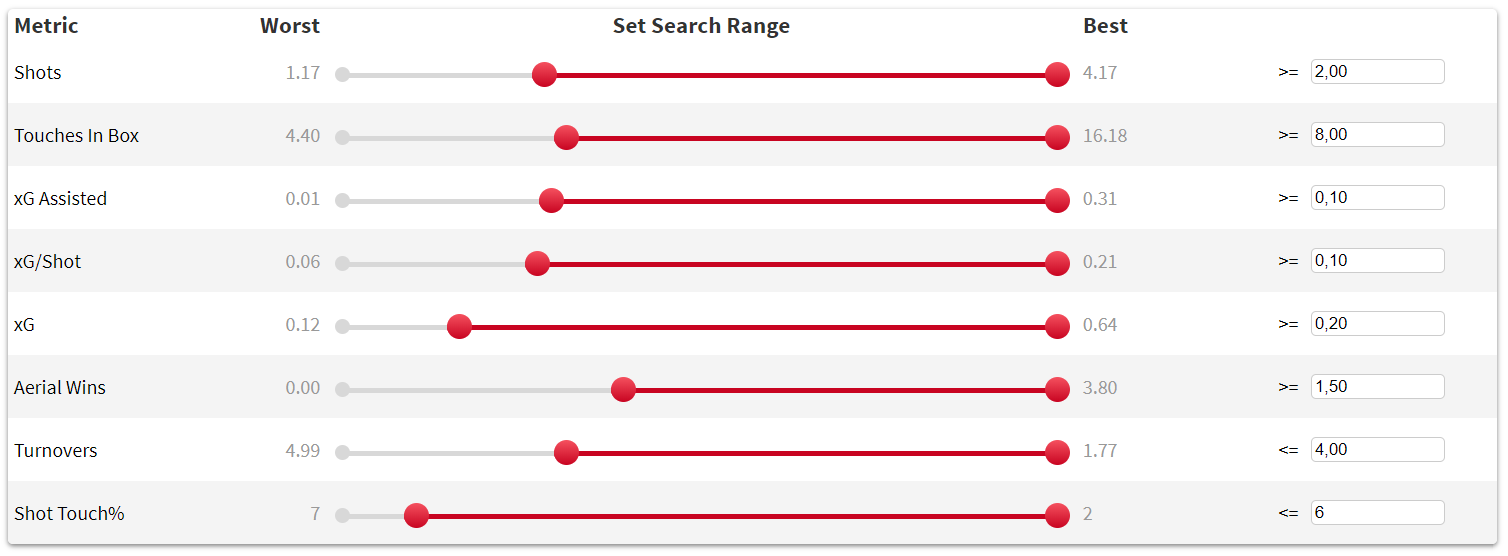 These criteria, used for last and this season, produces four results: André Silva, Gonçalo Paciência, Lucas Alario and, naturally, Robert Lewandowski. For Paciência, the result only refers to last season, in which he played only sparingly. In the current campaign, he would fall off the radar due to too many losses of possession, but he remains an interesting alternative to Silva and Alario regardless.
These criteria, used for last and this season, produces four results: André Silva, Gonçalo Paciência, Lucas Alario and, naturally, Robert Lewandowski. For Paciência, the result only refers to last season, in which he played only sparingly. In the current campaign, he would fall off the radar due to too many losses of possession, but he remains an interesting alternative to Silva and Alario regardless. 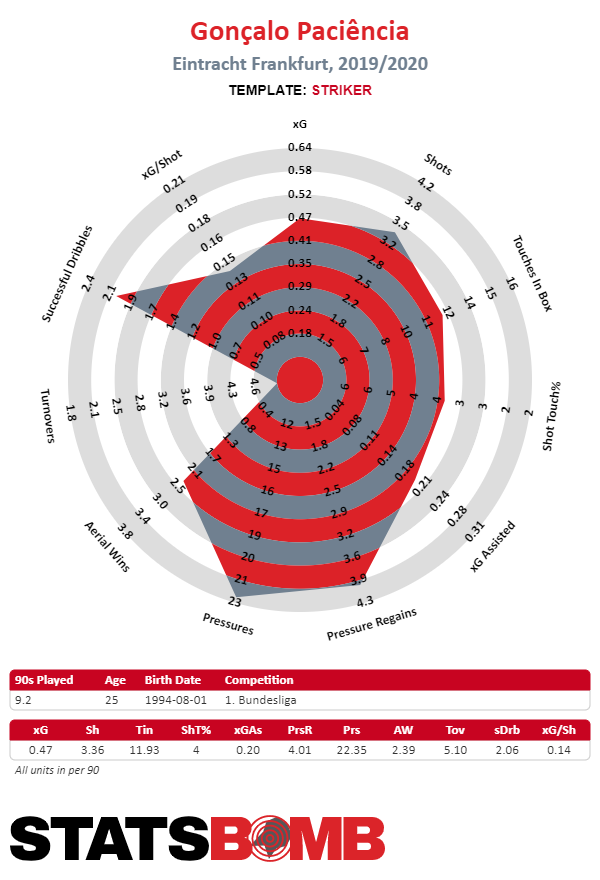 Those two, in turn, differ from one another in the way they participate in general play. Silva is more involved in situations in which he is not the one to look for the shooting attempt, rather setting up players from a zone ahead of the penalty box. Of course, this is also down to the playing style of Eintracht Frankfurt, in whose 3-4-1-2 or 3-5-2 the ball-near striker drops deeper during attacks along the wings. Particularly when playing over Filip Kostić, Silva drops back a bit, meaning he is not the furthest-most target player. Alario, on the other hand, constitutes a classic spearhead in the Bayer Leverkusen system, playing a role more oriented toward shooting attempts in comparison to Alcácer, which is why he is less likely to take part in the prepared combination play, bus also why he loses possession in the final third less often.
Those two, in turn, differ from one another in the way they participate in general play. Silva is more involved in situations in which he is not the one to look for the shooting attempt, rather setting up players from a zone ahead of the penalty box. Of course, this is also down to the playing style of Eintracht Frankfurt, in whose 3-4-1-2 or 3-5-2 the ball-near striker drops deeper during attacks along the wings. Particularly when playing over Filip Kostić, Silva drops back a bit, meaning he is not the furthest-most target player. Alario, on the other hand, constitutes a classic spearhead in the Bayer Leverkusen system, playing a role more oriented toward shooting attempts in comparison to Alcácer, which is why he is less likely to take part in the prepared combination play, bus also why he loses possession in the final third less often. 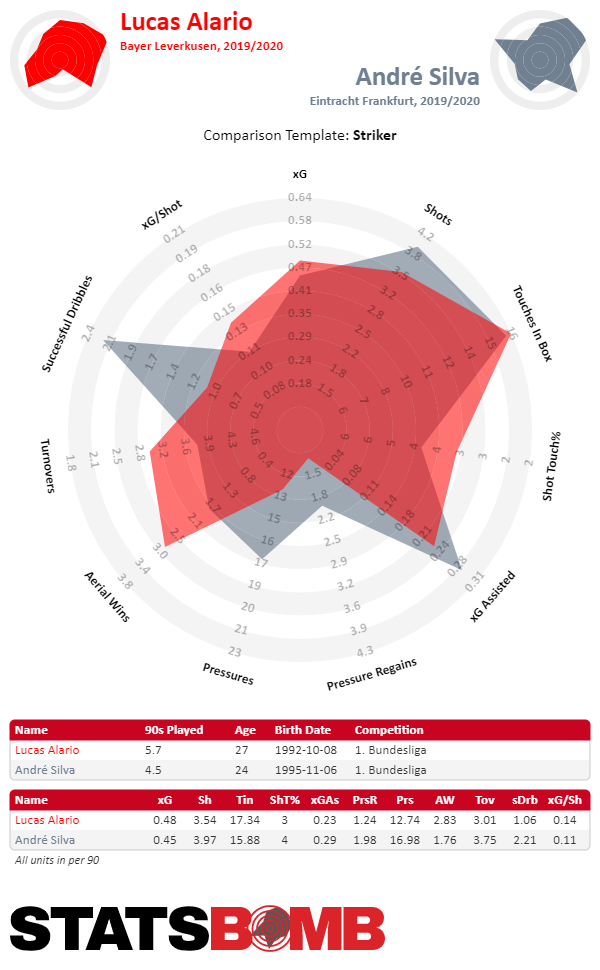 Silva, Alario and even Paciência offer the physical qualities needed for the proposed profile. The last two seem a tad stronger in the air, which can become apparent in pressure situations within the penalty box. Silva and Alario also have sufficient footballing qualities to not represent a steep decline from the rest of Dortmund's attack where they would only function as a last-resort target player and force BVB into attacking with nine instead of ten outfield players. The preferred option remains an attack with Alcácer. But for more tactical flexibility, for example, to increase the success rate of attacks over the wings or to play against an opponent's isolated high press, one of these strikers could help BVB.
Silva, Alario and even Paciência offer the physical qualities needed for the proposed profile. The last two seem a tad stronger in the air, which can become apparent in pressure situations within the penalty box. Silva and Alario also have sufficient footballing qualities to not represent a steep decline from the rest of Dortmund's attack where they would only function as a last-resort target player and force BVB into attacking with nine instead of ten outfield players. The preferred option remains an attack with Alcácer. But for more tactical flexibility, for example, to increase the success rate of attacks over the wings or to play against an opponent's isolated high press, one of these strikers could help BVB.
Appendix: A Foreign Alternative?
The current rumour mill concerning a new central striker for Dortmund mostly focuses on players from outside the Bundesliga. An interesting candidate who would also fill the postulated criteria is Olivier Giroud. Due to his age, the Frenchman cannot be considered a long-term alternative, but perhaps an alternative to Alcácer for a few seasons. Giroud naturally distinguishes himself with his physical play, but likewise with a footballing quality that would not make him an alien element in Dortmund's attack. The 33-year-old receives the ball in the penalty box often enough, but at the same time can involve himself in the general play from the outside and play layoffs in deeper counter-attacks. His numbers suggest as much. 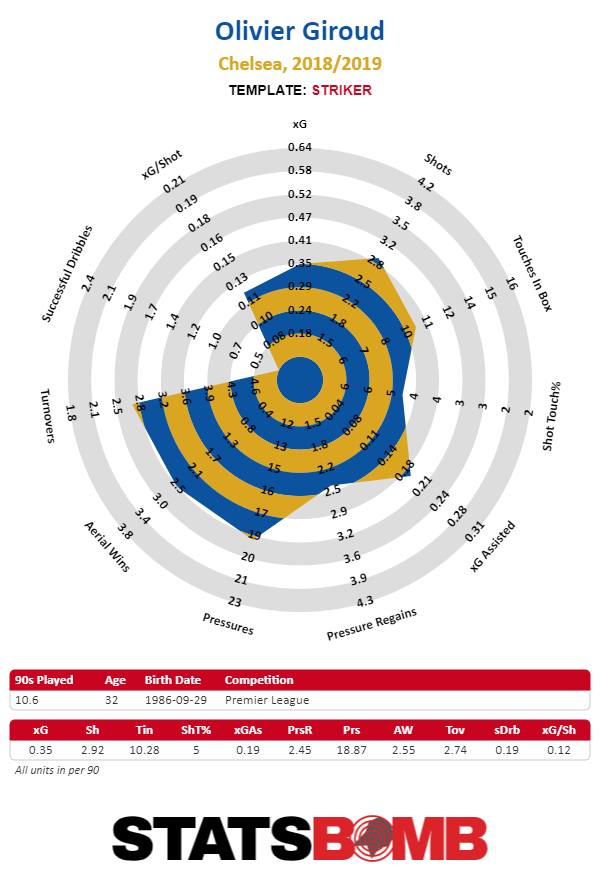 Another name, and one that would fit the category of “Fantasy Manager”, is Erling Håland of Salzburg, arguably the most wanted young striker in Europe. His fit at BVB is not an obvious one, however. While Håland is outstanding in terms of offensive productivity, a few smaller technical mistakes in his ball-handling abilities leave some question marks. Salzburg's playing style is predicated on a certain verticality and openness to risk, so a few losses of possession at the top of the formation are not a big problem. However, Håland does not seem to be overly stable in sophisticated combinations. Additionally, he has to prove how far he can develop other components of his finishing game given his height and physicality — especially in the air. Right now he is probably not a realistic option for BVB, even though they have a strong need for a big talent and have the ambition to attract this kind of player. You can also find this article in German on Spielverlagerung.de. Header image courtesy of the Press Association
Another name, and one that would fit the category of “Fantasy Manager”, is Erling Håland of Salzburg, arguably the most wanted young striker in Europe. His fit at BVB is not an obvious one, however. While Håland is outstanding in terms of offensive productivity, a few smaller technical mistakes in his ball-handling abilities leave some question marks. Salzburg's playing style is predicated on a certain verticality and openness to risk, so a few losses of possession at the top of the formation are not a big problem. However, Håland does not seem to be overly stable in sophisticated combinations. Additionally, he has to prove how far he can develop other components of his finishing game given his height and physicality — especially in the air. Right now he is probably not a realistic option for BVB, even though they have a strong need for a big talent and have the ambition to attract this kind of player. You can also find this article in German on Spielverlagerung.de. Header image courtesy of the Press Association
